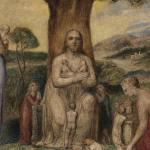Some notes following a discussion about Job with the Theopolis Fellows.
1) Theopolis student John Crawford pointed out that Job is described as blameless (tam) at the outset of the book. It’s the same word used for Noah, Abraham, and Jacob but it is also used in the sacrificial system.
An offering must be without blemish (tam), and so must a priest. In these contexts, the word means “free from physical defects,” defects that would make an offering unacceptable on Yahweh’s table and would disqualify a man from approaching that table or Yahweh’s house.
That term, and the references to sacrifice at the beginning (Job offering on behalf of his children) and end (Job offering sacrifice on behalf of his friends) set up a sacrificial sequence. Job himself is the offering, suitable to be brought into the presence of Yahweh, but only through sword and fire.
That is exactly the plot of the book: This blemish-less human sacrifice passes through the fire and sword of the accusations of his friends, in order to come into the presence of the God of the whirlwind.
That sequence deepens the Christological dimensions of the book (Job the suffering servant who is vindicated) by highlighting the scope of Jesus’ sacrifice. When, we may ask, did Jesus offer Himself as sacrifice? Certainly on the cross, but from the perspective of Job the sacrificial movement includes His suffering at the hands of accusers and His eventual vindication/resurrection. One might even say that Jesus began to pass through the sword and fire as soon as He took flesh.
2) John also took note of the “apocalyptic” character of the book. At the beginning, the veil of heaven is drawn back and we glimpse the heavenly court, where the sons of God assemble and Satan brings his accusations against blameless Job.
That apocalypse or “unveiling” is completed when Job enters the presence of Yahweh at the end of the book, when Yahweh unveils Himself as Creator and Caretaker of all and everything. At the end of the book, Job is in Yahweh’s presence and the Satan is not.
When we combine the sacrificial and apocalyptic dimensions of Job, we can see analogies with the book of Revelation. There too the curtain is opened and we see heaven even more fully than in Job. One of the main threads of Revelation is the movement of the martyrs from beneath the altar to heavenly thrones. They are a company of Jobs, who witness to God’s justice through the fires of persecution, who take the heavenly position that the dragon once occupied (cf. Revelation 12).
3) Throughout the debates with his friends, Job expresses the desire to see God in order to present his case. He does finally see God, and that sight gives understanding that he did not have before (42:1-6). He is an Adam who receives the fruit of knowledge so that his eyes are open.
Whether he is a fallen or an upright Adam depends on how we take 42:6: “I retract, and I repent in dust and ashes.” This might be taken as an admission of some degree of guilt, but it need not. “Repent” translates nacham, rather than the more usual shuv (“turn”). Nacham can connote a change of mind or regret without any hint of sin (Genesis 6:6-7).
Job acknowledges he’s spoken out of ignorance. Now that he sees, he sees his earlier partial blindness for what it was.












